Antibiotic Resistance of Community and Hospital Acquired Methicillin-Resistant Staphylococcus aureus Isolates from Clinical Specimens
- 1 Hawler Medical University, Iraq
- 2 Ministry of Higher Education and Scientific Research (KRG), Iraq
Abstract
Problem statement: Methicillin-Resistant Staphylococcus aureus (MRSA) is responsible for an increasing number of serious hospital and community acquired infections. Increased emergence in MRSA resistance to antibiotics is a growing problem. Approach: The resistance of MRSA to 20 antibiotics agents were studied. Also comparison of antibiotics resistance of community and hospital acquired MRSA were performed. Meanwhile the profile of antibiotics resistance of different clinical specimens among community and hospital acquired MRSA were evaluated. The clinical specimens of wound, urine, diabetic foot, skin abscess and sputum were collected from 1189 patients from March 2008-2009 at Hawler, Maternity and Rizgary teaching hospitals in Erbil, Iraq, 377 of Staphylococcus aureus were isolated and identification by standard methods, 114 MRSA were detected by detection PBP2a. Antibiotics resistance for MRSA were determined by the agar dilution method according to CLSI and BSAC guidelines. Results: The percentages of resistance in all hospital acquired MRSA were higher than community acquired MRSA. Among community acquired MRSA, the highest percentage (73.33%) of wound specimens were resistance to tetracycline, erythromycin and azithromycin. About 14% of urine samples were resistance to tobramycin, levofloxacin, moxifloxacin and rifampicin, 12.5% of diabetic foot was resistance to tobramycin, moxifloxacin and rifampicin. The resistance to tobramycin and rifampicin among MRSA cause skin abscess were 10 and 75% of sputum specimens were resistance to azithromycin and ciprofloxacin. Among hospital acquired MRSA isolates, 92% of wound specimens were resistance to tetracycline, 85.71% of urine samples were resistance to erythromycin and azithromycin. All sputum specimens were resistance to erythromycin. Conclusion/Recommendations: The most antibiotics affected agents MRSA were gatifloxacin, moxifloxacin and rifampicin. Physicians should be aware about MRSA and order for diagnostic and antibiotics sensitivity test. The use of antibiotics on random scale without antibiotic sensitivity testing must be restricted.
DOI: https://doi.org/10.3844/amjsp.2011.65.71

- 6,309 Views
- 3,735 Downloads
- 1 Citations
Download
Keywords
- Methicillin-Resistant Staphylococcus aureus (MRSA)
- antibiotic resistance
- Penicillin-Binding Protein (PBP)
- nucleic acid
- clinical specimens
- soft-tissue infections
- controlling nosocomial transmission
- hospital acquired
- antibacterial agents
